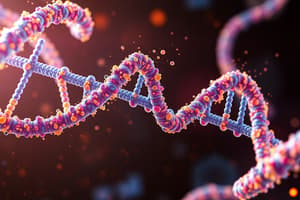Podcast
Questions and Answers
What distinguishes the backbone of RNA from that of DNA?
What distinguishes the backbone of RNA from that of DNA?
- RNA's backbone contains thymine, while DNA's backbone contains uracil.
- RNA's backbone is more stable than DNA's backbone.
- RNA's backbone is formed by hydrogen bonds, while DNA's backbone is formed by phosphodiester bonds.
- RNA's backbone contains ribose, while DNA's backbone contains deoxyribose. (correct)
Which bases in DNA are linked by two hydrogen bonds?
Which bases in DNA are linked by two hydrogen bonds?
- Cytosine and uracil
- Adenine and guanine
- Adenine and thymine (correct)
- Guanine and cytosine
What is the significance of complementary base pairing during DNA replication?
What is the significance of complementary base pairing during DNA replication?
- It allows DNA to define its coding region.
- It ensures the accurate copying of genetic information. (correct)
- It prevents DNA templating from occurring.
- It makes single-stranded DNA more stable.
What role do histones play in the packaging of DNA?
What role do histones play in the packaging of DNA?
Which structure is formed when DNA wraps around histones?
Which structure is formed when DNA wraps around histones?
Which of the following is a primary structural component found in both DNA and RNA?
Which of the following is a primary structural component found in both DNA and RNA?
Which sugar is found in the structure of RNA but not DNA?
Which sugar is found in the structure of RNA but not DNA?
What connects the nucleotides in a DNA or RNA strand?
What connects the nucleotides in a DNA or RNA strand?
In the structure of DNA, which part of the nucleotide interacts to form the backbone?
In the structure of DNA, which part of the nucleotide interacts to form the backbone?
Which nucleotide base is found in RNA but not in DNA?
Which nucleotide base is found in RNA but not in DNA?
What is the pairing partner of adenine in RNA?
What is the pairing partner of adenine in RNA?
Which feature is unique to DNA compared to RNA?
Which feature is unique to DNA compared to RNA?
What is the structural consequence of RNA containing ribose instead of deoxyribose?
What is the structural consequence of RNA containing ribose instead of deoxyribose?
Flashcards are hidden until you start studying
Study Notes
Structural Components of DNA and RNA
- Phosphate group: A primary structural component found in both DNA and RNA.
- Deoxyribose sugar: Found in DNA, but not RNA.
- Ribose sugar: Found in RNA, but not DNA.
- Phosphodiester bonds: Connect nucleotides in a DNA or RNA strand.
- Phosphate group and deoxyribose sugar: Interact to form the backbone of DNA.
Nucleotide Bases in DNA and RNA
- Uracil: Found in RNA, but not DNA.
- Thymine: Found in DNA, but not RNA.
- Cytosine: Found in both DNA and RNA.
- Adenine: Found in both DNA and RNA.
- Uracil: Pairing partner of adenine in RNA.
- Guanine: Pairing partner of cytosine in both DNA and RNA.
- Adenine and cytosine: Nucleotide bases common to both DNA and RNA.
- Uracil and adenine: Base pair not found in DNA.
Structural Differences Between DNA and RNA
- Double-stranded structure: Unique to DNA, RNA is typically single-stranded.
- Deoxyribose sugar in DNA, ribose sugar in RNA: Key structural difference between the sugars found in DNA and RNA.
- RNA being typically single-stranded: A structural consequence of RNA containing ribose instead of deoxyribose.
- Ribose in RNA, deoxyribose in DNA: Difference in the backbone of RNA and DNA.
Complementary Base Pairing in DNA and RNA
- Adenine and thymine: Held together by two hydrogen bonds in DNA.
- Complementary base pairing in DNA replication: Ensures the accurate copying of genetic information.
DNA Packaging
- Histones: Help condense DNA into chromatin.
- Nucleosome: Structure formed when DNA wraps around histones.
- Histones: Modify how tightly DNA is packed, affecting accessibility for transcription.
Studying That Suits You
Use AI to generate personalized quizzes and flashcards to suit your learning preferences.







